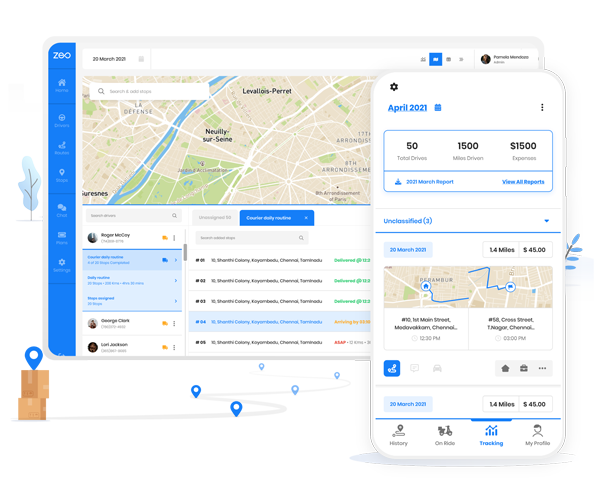Updated on: April 16, 2025
Behind every successful fleet lies a driver who feels valued, supported, and equipped to excel.
Fleet management isn’t just about keeping vehicles moving, it’s about keeping drivers motivated, safe, and efficient. In the logistics industry where every route, delivery, and decision impacts the bottom line, driver management and well-being are essential.
As fleets grow in size and complexity, driver management effectively has become a critical challenge for businesses. The secret to thriving in this evolving landscape lies in adopting strategies that boost both productivity and morale, ensuring that drivers feel supported while the fleet operates at its peak.
Let’s explore how effective driver management strategies can transform operations and create a win-win for drivers and businesses alike.
Why Driver Management is Crucial for Businesses
Fleet management isn’t just about vehicles, it’s about the people behind the wheel. A driver who feels physically and mentally supported will naturally perform better, making timely deliveries while minimizing risks. Conversely, neglecting driver well-being can lead to costly mistakes, high turnover, and even safety hazards.
To succeed, fleet managers need to embrace a balanced approach towards driver management that boosts efficiency while addressing the unique challenges drivers face. Let’s explore why prioritizing well-being and performance is essential for growth.
- Burnout Is Bad for Business
The delivery and logistics industry is no stranger to driver burnout, caused by tight schedules, repetitive tasks, and high-pressure environments. Burnout doesn’t just affect performance, it can lead to accidents, absenteeism, and costly employee turnover.
Fleet managers can combat burnout by introducing fair workloads, flexible schedules, route optimization, and access to mental health support. Drivers who feel valued and rested are more engaged, motivated, and willing to go the extra mile for the business.
- Driver Satisfaction Drives Success
Retaining skilled drivers is one of the biggest challenges in the logistics industry. When drivers feel underappreciated or unsupported, they’re more likely to seek better opportunities elsewhere.
Simple strategies like regular feedback sessions, transparent communication, and performance-based incentives can build loyalty.
Satisfied drivers stay longer, reducing recruitment costs and ensuring consistent, reliable deliveries that strengthen your reputation.
Key Strategies for Boosting Driver Performance & Well-being
Driver management is about cultivating an ecosystem where they can thrive and succeed. Fleet managers play a pivotal role in creating this environment, and these strategies provide actionable ways to enhance driver satisfaction.
- Implement Route Optimization Tools for Improved Productivity
Fleet managers should prioritize route optimization tools as a foundational strategy. These tools streamline delivery planning by identifying the most efficient paths based on delivery schedules, vehicle loads, and distances.
By eliminating unnecessary detours and delays, drivers can focus on timely deliveries without the frustration of poorly planned routes. Incorporating route optimization ensures smoother workflows, reduces stress, and boosts driver productivity.
- Fatigue Monitoring and Timely Rest Breaks
Addressing driver fatigue is crucial for safety and performance. Fleet managers must leverage route planners to analyze driving route patterns and work hours to flag signs of exhaustion.
increase fuel savings
Hassle Free Deliveries & Pickups!
Optimize routes with our algorithm, reducing travel time and costs efficiently.
Get Started for FreeBy providing rest breaks and using technology to monitor distance travelled, businesses can prevent burnout and improve driver alertness. Promoting a culture where rest is valued not only safeguards the driver but also reduces the risk of operational disruptions due to accidents or overworked employees.
- Enhance Communication Channels for Real-Time Updates
To ensure delivery drivers feel supported, fleet managers should implement real-time communication tools. These systems allow seamless updates on routes, schedules, or last-minute changes, keeping drivers informed and connected.
In emergencies like breakdowns or bad weather, quick access to support minimizes delays and stress. Making communication a strategic priority not only boosts efficiency but also reassures drivers that they’re never alone on the job.
- Launch Driver Health and Wellness Programs
Fleet managers can drive significant improvements in performance and satisfaction by introducing wellness initiatives tailored to delivery drivers. Offering access to telemedicine, regular health check-ups, and ergonomic vehicle enhancements are practical ways to support driver health.
Using technology to monitor metrics like stress levels or sleep patterns empowers managers to act on potential health risks proactively. Healthy drivers are safer, more focused, and better equipped to meet the physical and mental demands of their roles.
- Leverage Performance Analytics for Personalized Coaching
Data-driven route analytics and insights are indispensable for creating tailored development plans for drivers. Fleet managers should adopt performance analytics to evaluate key metrics like delivery times, idle hours, and efficiency.
This data can be used to identify areas for improvement and design personalized coaching sessions. Drivers who receive constructive feedback are more engaged and motivated, fostering a culture of continuous growth.
Role of Technology in Transforming Fleet Management
Technology has revolutionized fleet management, offering tools that streamline operations while addressing driver performance and well-being. Here’s how cutting-edge technology supports both driver performance and well-being:
- Route Optimization: Simplifies route planning and ensures timely deliveries, reducing stress for drivers.
- Workload Management: Tracks total distance travelled during deliveries encourages timely rest, safeguarding safety.
- Instant Communication: Keeps drivers connected and supported throughout the delivery process.
- Performance Analytics: Provides actionable insights for personalized coaching and skill development.
By integrating advanced technologies, modern fleet management goes beyond just optimizing routes, it prioritizes driver well-being alongside operational efficiency.
In this landscape, Zeo Route Planner emerges as a key enabler, bridging the gap between performance and support. From simplifying route planning to enhancing communication and ensuring driver safety, Zeo’s driver management tools are designed to empower fleets and their drivers, setting a new standard for success in the industry.
Conclusion
Fleet management is no longer just about trucks and schedules, it’s about people. Drivers are the backbone of the logistics industry, and their performance and well-being are directly tied to your success. By implementing strategies that prioritize their performance and well-being, you can build a more resilient, efficient, and motivated fleet.
Investing in driver management is an investment in the future of your business. Want to see how technology can transform your fleet management?
Schedule a demo with Zeo experts today and take the first step toward a smarter, more driver-focused operation.

Are you a fleet owner?
Want to manage your drivers and deliveries easily?
Grow your business effortlessly with Zeo Routes Planner – optimize routes and manage multiple drivers with ease.

increase fuel savings
Hassle Free Deliveries & Pickups!
Optimize routes with our algorithm, reducing travel time and costs efficiently.
Get Started for Free




















